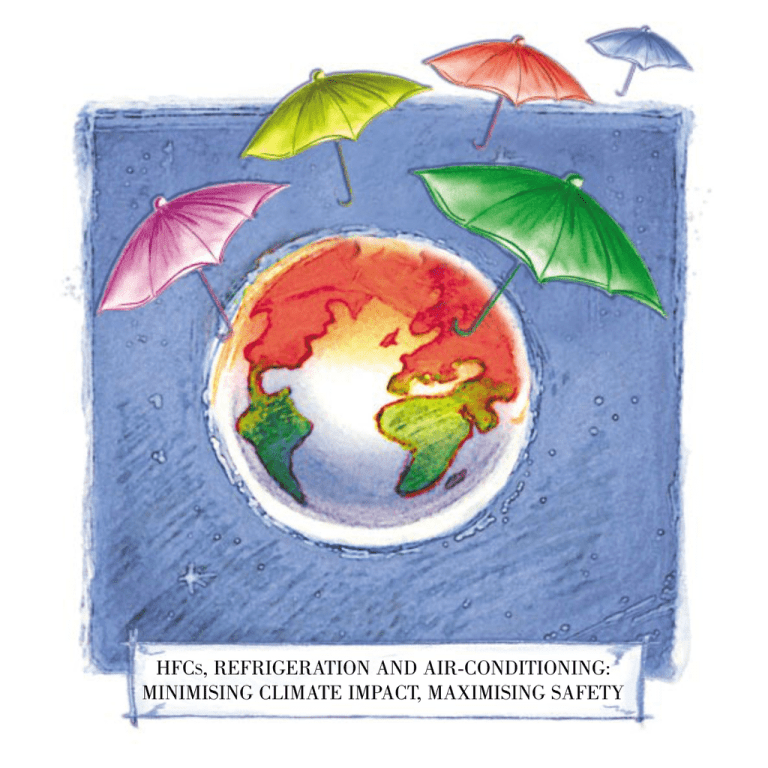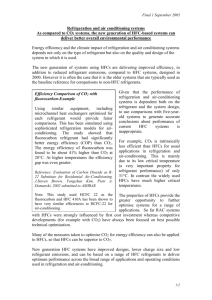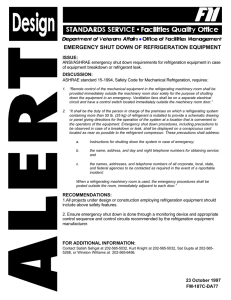hfcs, refrigeration and air-conditioning
advertisement

HFCS, REFRIGERATION AND AIR-CONDITIONING: MINIMISING CLIMATE IMPACT, MAXIMISING SAFETY HFCS, REFRIGERATION AND AIR-CONDITIONING: MINIMISING CLIMATE IMPACT, MAXIMISING SAFETY The impact of refrigeration and air-conditioning installations on climate change has been principally through energy consumption and the past emissions of CFCs. Now, more efficient installations and newgeneration fluids such as HFCs* (Hydrofluorocarbons) contribute to a 60% reduction in the global warming impact of refrigeration. As such, the refrigeration industry is one of the sectors that has made most progress in this area. Substituting CFCs with low leakage HFC systems that have improved efficiency will mean a net reduction in the effect on the global climate. This is the result of a pragmatic and responsible approach towards sustainable refrigeration that respects both the safety of the user and the environment. * HFCs (hydrofluorocarbons) are substances made of hydrogen, fluorine and carbon atoms. OUR QUALITY OF LIFE DEPENDS ON REFRIGERATION Refrigeration and air conditioning processes are now part of our way of life and it would be inconceivable for it to be any other way. They have become essential ingredients for maintaining and improving our quality of life. - The cooling chain enables the storage, transport and use of food items in ideal hygienic conditions, reducing loss and waste. - Refrigeration of many medical products such as vaccines and blood is indispensable for ensuring their preservation. - Air conditioning, particularly in hot countries, brings comfort in places such as homes and occupational buildings, shops and public transport and contributes to maintain hygienic conditions in hospitals. - Thermal insulation using high-efficiency foams reduces energy consumption in buildings, refrigerated transport and cold rooms. HEALTH, SAFETY AND THE ENVIRONMENT : RESPECTING PRIORITIES FOR A BETTER FUTURE - Refrigeration is essential for the operation of equipment such as large IT systems through to the most sophisticated medical applications. (A) (D) (C) Using the benefits of an activity while ignoring its impact on the environment is not an option today. As citizens, industrialists or politicians we need to understand the environmental challenges. Only then can we make responsible decisions to ensure sustainable socio-economic development. Objectively evaluating the real impact of a refrigeration system on the environment requires an understanding of effects through the whole life cycle. This is the only way to take into account more than just the effects of a part of the system on global warming. (B) The refrigeration cycle: The refrigerant absorbs the heat ( ) as energy source to evaporate in the closed space (A). The vapor is then compressed (B) and re-condensed outside (C) to release the heat. The liquefied refrigerant (D) is ready for a new cycle. THE WORLD OF REFRIGERATION FLUIDS Ammonia Ammonia was the first refrigerant to be used on a large scale. It is efficient, but it is also very toxic and flammable. That is why safer substitutes have often been preferred and ammonia is now generally restricted to use with supervision by skilled personnel (for example, cold stores, dairies, and breweries). However the systems to ensure safety involve a 30% to 40% cost premium compared to using less dangerous fluids. Hydro-chlorofluorocarbons H-CFCs HCFCS were developed in parallel with CFCs (chlorofluorocarbons) and, together, they provided the spectacular social development of safe, cheap and effective refrigeration. HCFCs have a small affect on the ozone layer. They were labelled “transitional substances” in 1990 and their production and use will be phased out. In 1990 their contribution to greenhouse gas emissions was only 0.5% of the total that year. Hydrocarbons Propane or Isobutane Hydrofluorocarbons HFCs Hydrocarbons (LPG) are also efficient refrigeration fluids. However they are very flammable, potentially explosive, and thus dangerous. In some countries, their use is restricted or banned in public places and tall buildings. Hydrocarbons also contribute to urban pollution as they trigger the generation of tropospheric ozone in the lower atmosphere. Their global warming potential is low but safety requirements can increase energy consumption and CO2 emissions. HFCs are pratically non-toxic and nonflammable. They can be used in a large number of applications and equipment can be serviced and maintained by the large existing trained base of installers. HFC present minimum risk, even in the case of an accidental leak. They also offer very good energy performance. However, whilst they have no effect on stratospheric or tropospheric ozone, they are greenhouse gases. THE IMPACT OF A REFRIGERATION SYSTEM ON THE GLOBAL CLIMATE The impact of refrigeration and air conditioning systems on global warming is through both energy use and refrigerant emissions. ENERGY USE REFRIGERANT EMISSIONS Refrigeration equipment consumes electricity, produced in general by burning fossil fuel that emits CO2 (carbon dioxide) into the atmosphere. This gas is the main contributor to greenhouse gas emissions that could lead to global warming and climate change. By the simple fact of consuming energy over its life cycle, any refrigeration unit contributes to climate change. This “indirect” effect can represent more than 80% of its impact. Poorly designed, badly maintained installations or refrigeration units abandoned at the end of their life without recovering or recycling the refrigerant fluid can lead to emissions into the atmosphere. These emissions are known as the “direct” effect. The substantial progress made in sealing modern units and in recycling fluids has brought about a considerable reduction in these emissions. The direct impact of refrigerant fluids on climate change is relatively small now and, in general, is decreasing. CO2 INDIRECT EFFECT Energy use 80 % DIRECT EFFECT Refrigerant Emissions 20 % Reducing the indirect impact due to energy consumption is the highest priority for the management of refrigeration systems. THE PRIORITY ISSUE: ENERGY EFFICIENCY The reduction of indirect impact of refrigeration and air-conditioning units lies essentially in the improvement of their energy use. The energy consumption is affected by three main parameters. The choice of the refrigerant fluid The quality of systems Matching and optimising the components which make up a refrigeration system is an essential part in the design of systems that consume less energy. It is also crucial to check system integrity so as to avoid refrigerant leaks. The quality of unit insulation Good insulation maintains heat gain to refrigerated cold spaces and provides a better energy return. In blown insulation foam, it is the entrapped gas - not the polymer material - which determines the degree of insulation. Life-cycle studies show that insulation foam blown using HFCs can be more efficient and longer-lasting than that using other blowing agents such as hydrocarbons, water or CO2. The perfect refrigerant does not exist. Refrigerant fluids are chosen for their thermodynamic efficiency to extract heat and for their safety in use. Ammonia and some hydrocarbons, whilst they are excellent refrigerants, are extremely flammable or toxic and demand maximum attention to safety and strict precautions. For example, in the case of ammonia being used as the refrigerant in supermarket freezers, safety procedures require the use of a "double circuit" system with ammonia restricted to the circuit outside the building. This inevitably involves a loss of refrigerating efficiency, which increases the energy use. As a result, electricity consumption and associated costs are distinctly increased. While HFC must be contained, they do not require the same safety precautions. They can be used across a wide range of application temperatures and can be more carefully selected to optimise system efficiency. HFCs are thus far more generally used. WORKING TOGETHER TO REDUCE HFC LOSSES Environmental awareness, increased recycling of refrigerants, improved maintenance and tightness reduce losses and accidental direct emissions of refrigerants to the minimum. Optimal tightness Rapidly evolving equipment design in recent years has dramatically improved the tightness of refrigeration systems and reduced losses. Systematic recycling HFCs can be easily recycled and re-used by refrigeration service engineers. Refrigerant producers have made a commitment to the principles of “responsible refrigeration”, including the promotion of recovery and recycling. A proposed European Union Directive on the recycling of electric and electronic equipment will require the recycling of domestic appliances. Among other things, this will promote the extension of systems to collect used refrigerant. Training and Standards Certification of companies and training maintenance personnel, obligatory maintenance contracts and follow-up and verification of all these activities will ensure that the aims to reduce greenhouse gas emissions from refrigeration and air conditioning systems are achieved. HFCs HAVE A LOW IMPACT ON CLIMATE TABLE 1: Index Values of GWPS after 100 years Carbon dioxide (CO2) Methane Nitrous Oxide (N2O) ODS1 HFCs PFCs Sulphur hexafluoride (SF6) 1 21 310 100 to 8,000 140 to 11,700 6,500 to 9,200 23,900 ODS: Ozone Depleting Substances controlled under the Montreal Protocol PFCs: perfluorocarbons TABLE 2: Quantity Greenhouse Gases emissions in the year 2000 CO2 Methane N2O ODS1 HFCs PFCs SF6 30,800,000,000 350,000,000 11,000,000 600,000 140,000 20,000 6,000 tonnes tonnes tonnes tonnes tonnes tonnes tonnes If the Kyoto Protocol is successfully implemented,the total emission of Greenhouse Gases will begin to fall FIGURE 1: Lifetime INDEX Fraction still in the atmosphere Global Warming Potential (GWP) The global Warming Potential is an index that relates the potency of a greenhouse gas to that of carbon dioxide. By convention, the calculation integrates the effect from each gas over 100 years (table 1). On this scale, the GWP of a refrigerant such as HFC-134a is 1300, which means that an emission of one kilogram would have the same impact over 100 years as an emission of 1300 kg of CO2. However, the GWP has to be put into perspective.The total quantity released is as important as the GWP in calculating the real environmental impact. CO2 HFC 134a Lifetime years IMPACT= INDEX x QUANTITY HFCs Clearly GWP as a measure does not satisfactorily describe the climate impact of a greenhouse gas. Despite the low GWP of CO2, the enormous quantities emitted and its long lifetime means that it has a far greater impact on climate than HFCs. Currently, CO2 emissions contribute 64% of the total greenhouse gas emissions and are rising. In contrast HFCs contribute much less than 1% today and are expected to rise to two or three percent by the end of the century. CO2 QUANTITY LIFETIME The quantities emitted Lifetime of greenhouse gases in the atmosphere The atmosphere naturally contains greenhouse gases such as CO2, methane and water vapour that have maintained a mean terrestrial temperature around 15°C. Humans are adding carbon dioxide into the atmosphere by burning fossil fuels for power, transportation and industry. Agriculture also leads to methane emissions. These sharp increases in greenhouse gases change the climate balance. When considering impacts, the relative quantities of greenhouse gases emitted to the atmosphere must be taken into account; HFCs are emitted in tiny quantities compared to CO2 or methane (table 2). The longer a greenhouse gas stays in the atmosphere, the more its cumulative heating effect. Although the GWPS are calculated on a 100 years basis, lifetime becomes an important parameter for the longer term. Actually, CO2 has a very long lifetime: it remains in the atmosphere for several thousand years and after 100 years has developed less than one quarter of its impact. In contrast, the lifetimes of HFCs are decades or less. Unlike HFCs, which are removed from the atmosphere relatively quickly, the long lifetime of CO2 means a significant commitment for climate change long into the future. (figure 1). SAFETY AND REFRIGERATION In spite of all precautions being taken, an accident or some act of negligence can be translated into leaks of refrigerants. However, if it's a minor and limited accidental HFC loss, it will have no significant consequence at the global climate level. Such an event - if it concerns a toxic or explosive gas - could possibly be catastrophic for the people involved. Accidents with toxic or explosive refrigerants have already occurred with serious consequences. The risk of a fatality from ammonia refrigeration systems is estimated to be at least 1.5 per million installations per year (Source - IEA). If the 30 million commercial and industrial refrigeration systems estimated to be in the EU were all operated on ammonia this could result in many additional fatalities each year. For larger systems, with higher refrigerant charge, risks are likely to be even higher for hydrocarbons than for ammonia because of the high flammability. A SUSTAINABLE AND RESPONSIBLE SOLUTION FOR THE FUTURE WITH HFCs: NO LONGER A CHOICE BETWEEN SAFETY AND EFFICIENCY Managing Emissions Significant advantages Managing the emissions of HFCs renders their impact insignificant. Their use in well designed, efficient refrigeration systems results in reduced environmental impact. - In refrigeration, the range of HFCs and their many possible combinations means that we can choose a mixture which corresponds exactly to the level of cooling required, whether it is for domestic refrigerators, large freezer units, refrigerated storage, or air-conditioning systems. - For insulation, foams blown with HFCs have demonstrated their superior ecobalance; - From the users' and consumers' safety perspective, HFCs present minimal risks. They are practically non-toxic and non-flammable, providing a reliable option that minimises risk in a wide range of industrial, public, residential or transport situations. Even if all the HFCs used in refrigeration were to be sent into the atmosphere, their impact on global warming (even in this worst case) would, in the near future, represent no more than 1.6% of the greenhouse gas impact. In practice, emissions on this scale will not occur and strenuous efforts continue to be made to eliminate refrigerant losses from installations. The use of HFCs for efficient installations safely and significantly reduces the climate warming impact of refrigeration and air conditioning. This move towards sustainable development in the refrigeration sector is the responsible and safe way to meet a goal of full respect for our environment. In this way HFCs are part of the ideal solution : Less CO2 Energy Efficiency HFC use Safety + Protected Climate SEVEN SOLUTI FOR REDU AND AIR- Focus on energy efficiency improvement in refrigeration through better design, installation and operation of equipment. This would reduce the indirect emissions that are over 80% of the contribution here Focus on reduction of greenhouse gas emissions, as required by the Kyoto Protocol, not on regulation of uses Maintain a choice of refrigerants for optimum performance in terms of safety, efficiency, environmental impact and cost Maintain public safety as a primary consideration, there is no need to compromise existing safety levels 1 2 3 5 6 7 Establish a structured refrigerant recovery and recycling system, eliminating unnecessary regulatory barriers Promote and support voluntary initiatives aimed at preventing greenhouse gas emissions, recognising that verification is essential to their success Discourage discriminatory regulatory initiatives that have no objective benefit for the environment and safety. 4 ONS UCING THE CLIMATE IMPACT OF REFRIGERATION CONDITIONING




